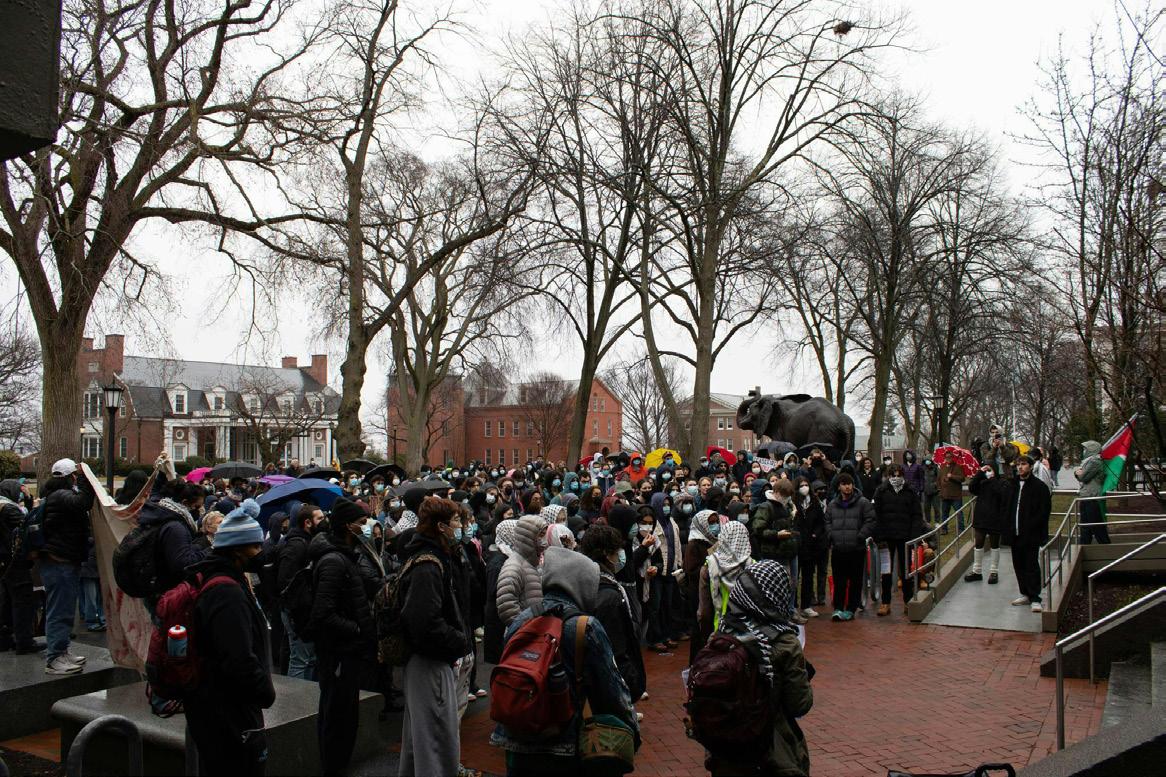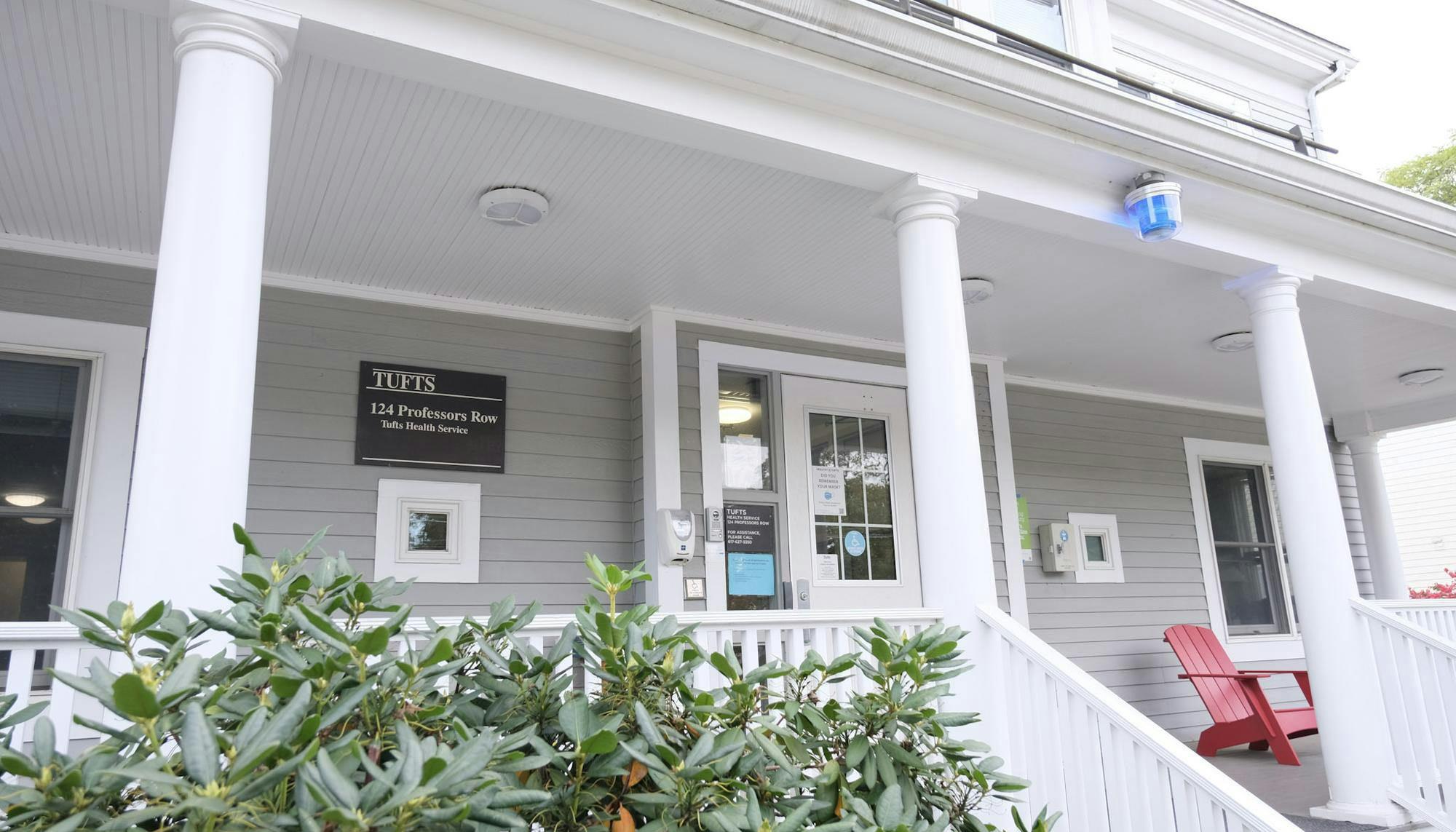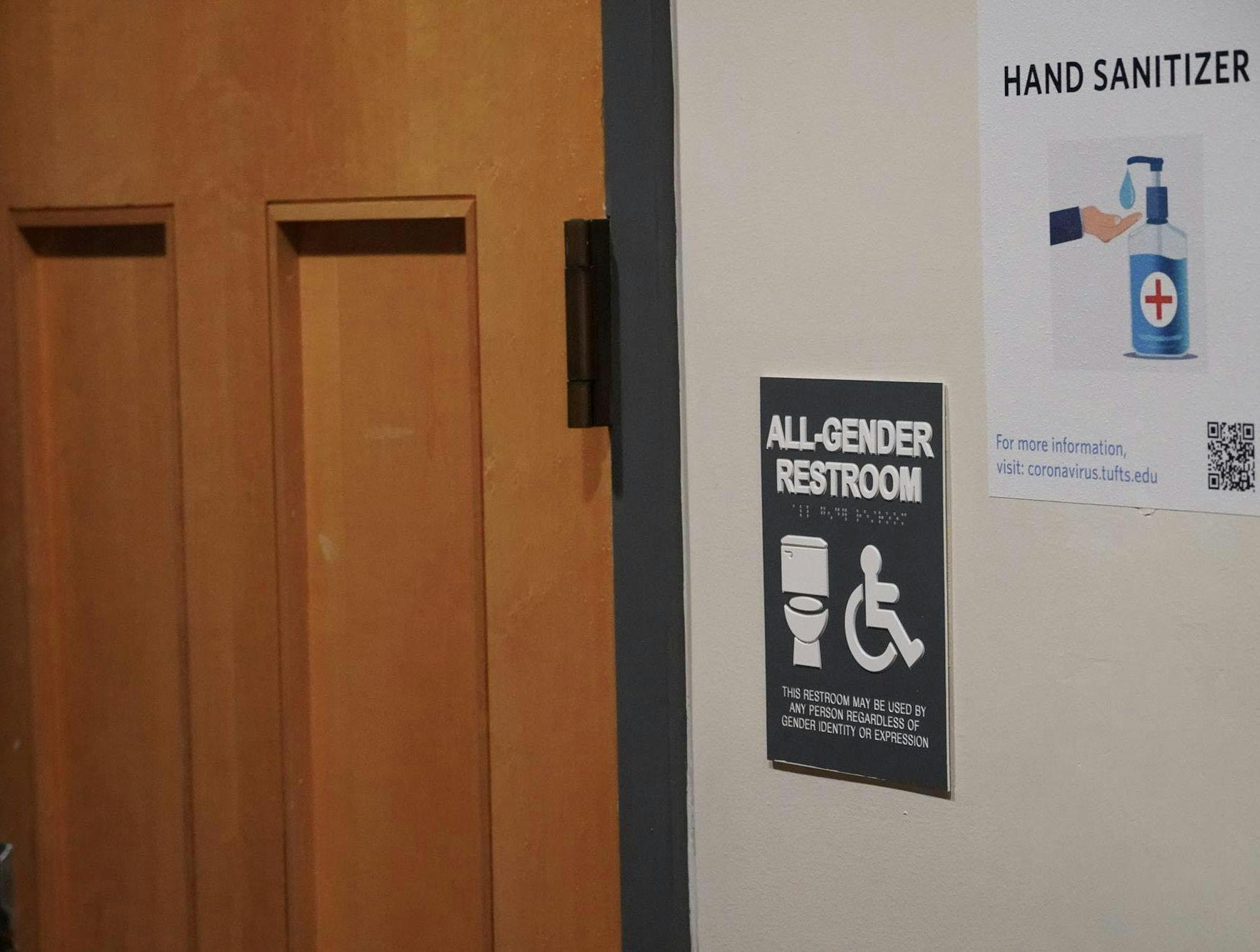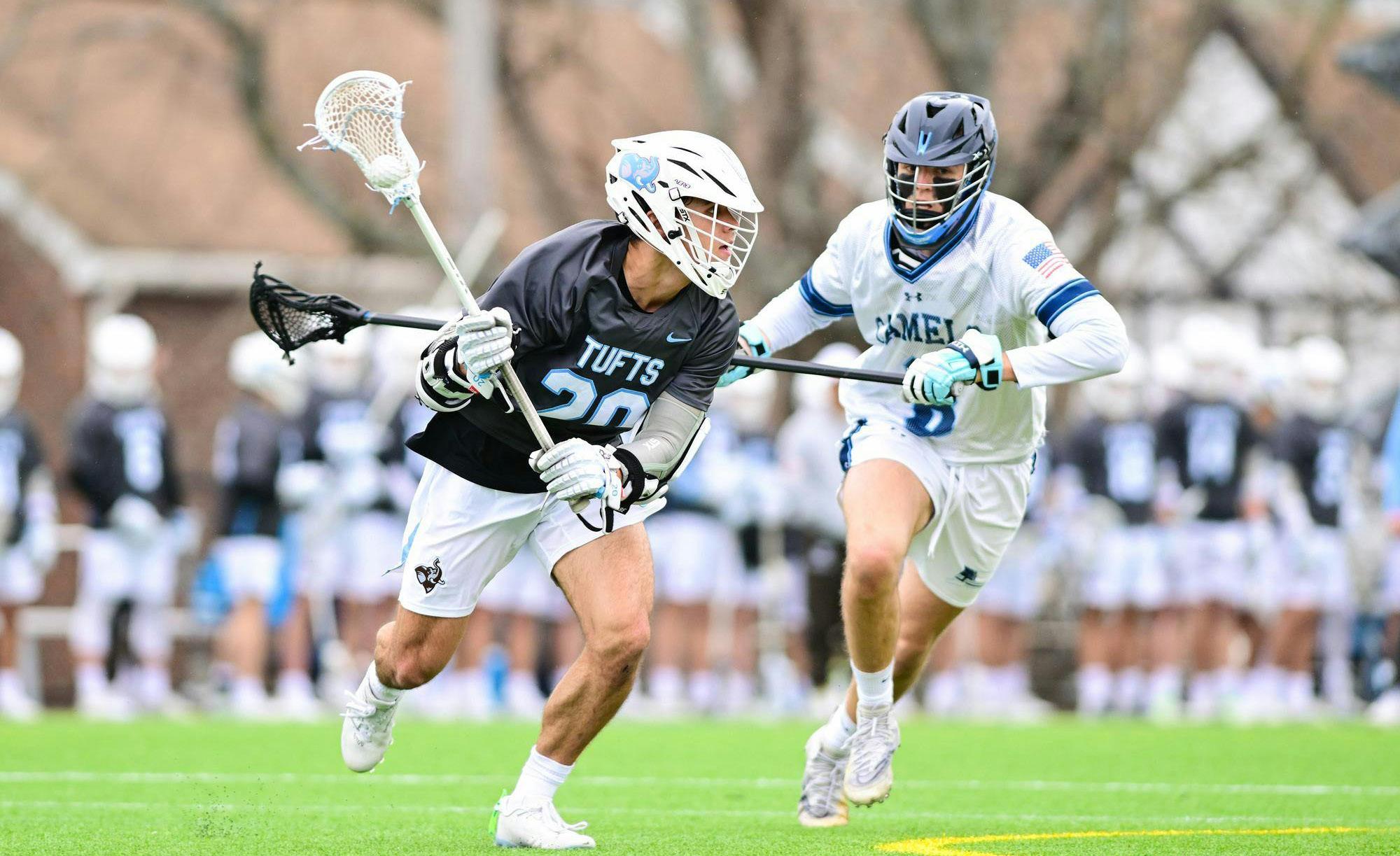The Tuf T s Daily
TCU Senate calls on university to divest from Israel
Matthew Sage, Rachel Liu & Julieta Grané Executive News Editor, Editor in Chief, Managing Editor
Originally published March 4.
In the early hours of Monday, the Tufts Community Union Senate voted to approve three out of four resolutions formally calling on University President Sunil Kumar to recognize genocide in Gaza, for the university to divest from Israeli companies and for it to cease selling Sabra products in dining halls. It did not, however, pass a resolution calling on the university to end approval for study abroad programs at universities in Israel.
Even before the 7:45 p.m. Sunday start time, a crowd formed in front of the open meeting room in the Joyce Cummings Center. With a turnout of approximately 310 attendees, who spoke both in favor and against the resolutions, deliberations lasted 4 ½ hours before the Senate voted anonymously in a closed session,
releasing the results shortly after 3 a.m. Monday.
“We’re disappointed that a majority voted to pass three of the resolutions,” Patrick Collins, Tufts’ executive director of media relations, wrote in an statement to the Daily. “To be clear, as we have done in the past, we reject the boycott, divest, and sanction movement; we wholeheartedly support academic freedom and all our academic, exchange, and affiliated study abroad programs; and we will continue to work with all companies that we engage with and do business with now.”
The Coalition for Palestinian Liberation proposed the original resolution texts.
S. 24-1 demanded that the Global Education office end approval for study abroad programs at universities in Israel. To approve a resolution, the Senate must reach a simple majority. The voting ended in a tie with 16 senators in support, 16 against and three abstaining.
Thursday,
Students protest Kumar’s condemnation of TCU Senate resolutions
Matthew Sage Executive News Editor
In an email sent to the wider Tufts community on Monday, University President Sunil Kumar condemned the three recently passed Tufts Community Union Senate resolutions that called on the university to cut ties to Israel and to acknowledge the Palestinian genocide in Gaza. Sent less than 12 hours after the Senate announced results around 3 a.m., Kumar’s email sparked a student protest and die-in at Barnum Hall on Tuesday.
Kumar, and other senior leadership who signed the email, stated that despite the several hourslong deliberations which show “how our campus reflects the deep division in society on these issues,” they are “disappointed” that a majority of TCU senators voted to approve the resolutions. They reaffirmed the university’s stance against the global movement to end support for Israel, stating that the university sup-

ports all of its study abroad programs and will not halt current business relationships.
“The immense loss of life in Gaza is tragic. We mourn with the Palestinians, but we also feel for the Israelis grieving over those they have lost and share their desire for the safe return of the hostages. It is also possible for us to be supportive of both the right of Israel to exist and for the self-determination rights of the Palestinian people,”
administrators wrote. “However, these resolutions do not allow for these views to coexist and, as a result, force our community into opposing groups rather than uniting us to build from areas of agreement.”
Kumar wrote that the university will investigate reports of antisemitic and Islamophobic conduct from Sunday’s Senate meetings, where students both
Students allege police aggression at Nov. 17 protest for Palestine
Estelle Anderson Executive Investigative Editor
Student demonstrators held a protest at Ballou Hall in support of Palestine on Nov. 17, 2023, demanding that Tufts end its ties to Israeli institutions and denounce Israel’s assault on Gaza.
In the weeks following the protest, 18 students received disciplinary violations, one student had their study abroad privileges revoked and Tufts Students for Justice in Palestine publicly alleged on Instagram that Tufts University Police Department officers had engaged in physical and verbal harassment against students.
In a month-long investigation, the Daily interviewed student protesters, solicited statements from TUPD and reviewed video evidence and eyewitness accounts in an effort to understand what exactly happened during the demonstration. The Daily corroborated many of the protesters’ claims that officers used physical force and verbal
intimidation in a way that made students feel unsafe.
Student protesters whom the Daily interviewed requested anonymity due to fears of university retaliation.
“A really bad, bad experience”: Student demonstrators recount the protest Protesters arrived at Ballou at approximately 7:00 a.m. on Nov. 17. They proceeded to gather at the front, side and back entrances of the building, blocking the doors, which is a violation of Tufts policy. Approximately 50 students were in attendance, holding up signs, participating in chants and forming picket lines. Also at the scene were legal observers from the National Lawyers Guild, trained volunteers who monitor police officers’ behavior at protests. The legal observers were dismissed by officers at around 8:30 a.m. after being told that they could not be on Tufts’ campus because it was private property.
According to protesters, interactions between protesters and the

TUPD officers at the scene quickly grew tense. Videos reviewed by the Daily show several officers threatening protesters with the possibility of being arrested. In one video publicly posted on SJP’s Instagram, a TUPD officer physically presses up against a student and demands, “What would you like to be arrested for: assaulting an officer or resisting?”
In another video obtained by the Daily, officers threaten to arrest and charge students blocking the door with “felony kidnapping,” claiming that they were “holding people hostage inside of the building.” The Daily reviewed videos in which protesters repeatedly tell officers that they will let people out of the building. According to Tufts’ Chief of Police Yolanda Smith, no students were ultimately arrested or charged with a crime following the protest.
At around 9:15 a.m., officers called in maintenance staff to set up a barricade around the front and side entrances. Smith said that this was meant to limit the number



of students blocking the doors.
“They got increasingly aggressive,” one protester recounted. “They put up these barriers and they’re like, ‘nobody can cross the barriers.’ They’re filming all of us, getting all in our faces.”
Protesters sitting in front of the doors were sectioned off inside the barricaded area, while a crowd of students remained outside.
Several protesters whom the Daily interviewed also claimed that officers repeatedly stated that there was a “medical emergency” inside of Ballou, despite no ambulances or medical response ever arriving at the scene. In a statement to the Daily, Smith claimed, “We have no information suggesting that officers said there was a medical emergency inside Ballou.”
Protesters also allege that officers engaged in excessive physical aggression against students. In one video posted publicly on SJP’s Instagram, an officer repeatedly pushes his knee into the backs of two students sitting in front of the door, attempting



to break them apart. According to one protester, ”[The students] had to switch at some point because the kicking had gotten so bad that one of the protesters couldn’t take it anymore.”
“The scariest part was being threatened with a felony and … just having the cop physically assault and put their hands on us and try to rip our hands apart and step over us and dig their knee into our backs,” another protester recounted.
“I think generally they were not afraid to touch students,” another protester said. “They were not afraid to use their bodies to prevent people from violating what they’ve set up as a boundary.”
Protesters allege that one officer pinched the abdomen of a student attempting to join the protesters within the barricade. The Daily was unable to independently verify this claim.
When shown the publicly posted videos, Smith did not direct-
see POLICE, page 2


SCIENCE 10
NEwS INVESTIGATIVE FEATurES FuN & GAmES OpINION SpOrTS
2024 VOLUME LXXXVII, ISSUE 7 Medford/Somerville, Mass. THE INDEPENDENT STUDENT NEWSPAPER OF TUFTS UNIVERSITY EST. 1980 tuftsdaily thetuftsdaily tuftsdaily The Tufts Daily The Tufts Daily tuftsdaily.com 4 FEATURES 9 OPINION 12 SPORTS Planned Parenthood posits new plans The T can fare better Swim and dive surges to second 6 ARTS & POP CULTURE Boston songstress drops new single 1 1 4 6 8 9 12 ArTS & pOp CulTurE
March 7,
UNIVERSITY
RESOLUTION
UNIVERSITY
see
, page 3
6. see PROTEST, page
Originally published March
2
MATTHEW SAGE / THE TUFTS DAILY Over 150 protesters gathered on a rainy, overcast day at the protest on March 5.
INVESTIGATIVE
Founded in 1980,
The
Story tips? Questions? Concerns?
Let us know!
from page 1
for and against the resolutions allege they experienced instances of spitting, cursing and fighting. He also endorsed several university-sponsored initiatives to create “nuanced conversations.”
In response to Kumar’s email, the Coalition for Palestinian Liberation organized a protest of over 150 students outside of Barnum Hall on Tuesday.
“Students came out to show that despite months of repression and silencing we will never be silent,” the coalition wrote in a message to the Daily, saying that Tufts’ “denial of the democratic process was a direct attempt at silencing Arab students and students of color.”
The coalition’s choice of Barnum Hall — home to the Jonathan M. Tisch College of Civic Life — for its die-in was intentional. CPLT wrote that the college’s “alleged vision of anti-racism and civic engagement [is] clearly meaningless as long as they remain silent during suppression of student voices.”
Student speakers repeatedly denounced Kumar’s messaging, at one point taking specific issue with the university’s supposed failure to uphold one of its core values of respecting a “collaborative environment.”
“Instead of being met with understanding and acknowl-
edgement from the university, we were belittled, dehumanized and discredited. Our experiences were put into question and our narratives as Palestinians were undermined,” a student said. “We collaborated alongside 38 clubs, to be specific, on streamlining this principle of democracy and autonomy. We have finally decided to be involved in the bureaucratic political decision-making process, as is our right as students who attend this university.
… The facade of democracy built by Tufts completely collapsed with the university’s response email. The jarring dissonance that belies it displays a juxtaposition of what the administration claims to value versus the truth.”
Students also condemned Kumar’s support for structured university programs like “Dialogue & Action in a Time of Conflict.”
“We are entirely angered by both the events of the Senate meeting and the university’s abhorrent response,” the first speaker said. “We have always refused to come to the table with our colonizers and those who oppress us, creating a false equivalency between the colonizer and the colonized. Instead, we have organized the communities around us into fighting and advocating for our liberation.”
On the crowd’s periphery, stu-
dents reported that a Tufts faculty member, part-time mechanical engineering lecturer Harold Miller-Jacobs, asked a female protester, “Did you get raped?”
In a phone call with the Daily, Miller-Jacobs confirmed these allegations, and said that he expected the answer “to be no,” telling the protester, “many of the victims of Hamas cannot say that.” Miller-Jacobs claimed that protesters supported the terrorist organization Hamas, and that “advocating for them is horrendous.” During the protest, a speaker criticized “rhetoric equating Palestinians and the resolution writers to Hamas,” levied during Sunday’s Senate meeting. The crowd then marched from Barnum down to Gifford House — Kumar’s residence — and plastered flyers reading “Shame on Sunil Kumar” and “Shame on Tufts” on the door. Taking up positions on the front lawn, three South Asian students addressed the crowd.
“At the beginning of the semester, you expressed regret for having disregarded other perspectives and claimed to commit yourself to doing better,” one of these students said. “As a figurehead, your role requires you to take accountability for your actions and acknowledge the voices of your students, not erase
them. What is the purpose of your position if you are going to completely disregard what your students are asking of you?”
Traversing Packard Avenue and Talbot Avenue, then the covered stairwell of Mayer Campus Center, students walked up the stairs next to Tisch Library and eventually returned to Barnum Hall. The crowd then filled the building shortly after 3 p.m., staging a die-in by silently lying on the hallway floors. Students painted their hands with red paint and held flyers with the names and faces of several Tufts trustees, complete with the words “Complicit in Genocide” and “Divest Now.”
Inside Barnum, another student speaker criticized Tufts’ connection to the AntiDefamation League, which has previously funded Tufts University Police Department training trips to Israel.
“The ADL [claims] that they are an organization fighting injustice and antisemitism, but in reality, the ADL has only further entrenched the oppression of all marginalized groups including Jews like me,” the student said.
After around 40 minutes, students exited the building and dispersed after reading aloud a pledge for boycott, divestment and sanctions against Israel.
Protesters cite verbal, physical intimidation from officers
POLICE continued from page 1
-ly address the specific actions of officers depicted in the recording. In her statement, Smith wrote, “What has been provided to you was a snippet of a very long event.” Smith explained that officers are allowed to physically engage with individuals if other de-escalation measures such as verbal persuasion, warnings and orders do not resolve an incident.
“All TUPD officers are properly trained and certified regarding the use of force, which includes but is not limited to de-escalation tactics, responding to mass gatherings, and lawful use of force techniques,” Smith wrote.
The Daily reviewed notes from the legal observers which affirm several of the protesters’ claims, including officers threatening to charge students with felony kidnapping and acting aggressively toward protesters. Protesters claim that officers toned down their behavior once tour groups arrived in the area. The protest ended at around 12 p.m.
“The entire event was extremely, extremely traumatizing to a lot of students. A lot of people laugh it off, … but I think to me … it’s just so icky,” a student medic at the protest said. “It’s crazy that people don’t know about how horrible the protest was. It was just a really bad, bad experience for everyone.”
Protesters receive disciplinary violations; some stripped of study abroad privileges
As a result of their participation in the protest, 18 students were charged with disciplinary violations for violating four policies on Tufts’
Student Code of Conduct: Section IV (J), “gatherings, protests, and demonstrations”; Section IV (G), “failure to comply with a University official”; Section IV (D), “disorderly conduct policy”; and Section IV (E), “disruption or obstruction of community activity policy.” Disciplinary violations are handled by the Office of Community Standards and are addressed through the Student Conduct resolution Process, which can result in sanctions ranging in severity from a warning to expulsion from Tufts.
Junior Grace Borbon had their study abroad revoked after being found responsible for the four disciplinary violations and being identified as one of the individuals blocking the entrance to Ballou. As a result, Borbon was placed on disciplinary probation, which made them ineligible to study abroad. According to Borbon, TUPD was able to determine that they were at the Nov. 17 protest after an officer recognized them at a later protest and identified them using campus security footage. Borbon, who had planned to study abroad in Madrid, is now taking a gap semester.
“Students on campus should know how violent these cops are, and how they are being watched all the time and are constantly under surveillance,” Borbon said. “It was definitely something that all of us had theoretical knowledge of, but maybe not necessarily in practice.”
Issac Leib, a junior who attended the protest, had already been put on probation and stripped of his study abroad privileges prior to Nov. 17 due to disciplinary violations he received from previous pro-Palestine protests. According to Leib, TUPD identified him at
these previous demonstrations by using security camera footage and tracking his swipes into dining halls. The disciplinary violations that he received on Nov. 17 extended his probation period.
“It’s been pretty rough. There’s a ton of people at Tufts, students and faculty, who were super supportive,” Leib said. “But the systems that are in place are so anti-student, it feels like.”
Leib, who had planned to study abroad in Ghana, is currently on a leave of absence.
“If I had wanted to, I live in Somerville, so I could have just signed up for classes and commuted. But I just could not stop thinking about how if I was someone who was not from the area and had been subletting for a semester and then had these plans … fall through, … [I couldn’t] just come back to school without housing and take classes,” Leib said. “What is that person supposed to do? There’s just no support at all from the school as to how to navigate what to even do if you’ve been withdrawn from study abroad.”
TUPD responds to protesters’ claims
The Daily reached out to TUPD for its response to the events of Nov. 17.
“On Nov. 17, a group of demonstrators gathered outside Ballou Hall without notice, blocking all entrances and exits, preventing people from entering the building as they arrived to work and prohibiting those already in the building from exiting,” TUPD Chief of Police Yolanda Smith wrote. “This is a clear violation of university policy. TUPD asked demonstrators repeatedly to step
away from the doors to allow people in and out. The demonstrators refused. Several demonstrators were asked to produce student IDs, as required by the student code of conduct. Most refused. And most demonstrators disguised their appearances with masks, refusing to identify themselves.”
In her statement, Smith emphasized that both the university and TUPD support students’ right to protest but expect students to follow university policies that exist to preserve public safety. She explained that TUPD “routinely works closely with student groups and its colleagues in [the Dean of Students Office] to ensure that students are able to demonstrate safely.” According to Smith, the protesters who blocked Ballou in November did not coordinate their actions with TUPD or Tufts Student Life. regarding the disciplinary violations that students received, Smith wrote that the proceedings “might have been avoided had students complied with requests to avoid blocking the building.”
According to TUPD, no formal complaints of police misconduct have been filed in the months since the protest occurred.
Since November, student activism for Palestine has not abated. While shaken by their experiences on Nov. 17, students continue to pressure the administration to cut ties with Israel. In response to the administration’s rejection of Tufts Community Union Senate resolutions for divestment, students rallied outside Barnum Hall on Tuesday.
NEWS 2 THUrSDAY, MArCH 7, 2024 THE TUFTS DAILY
Visit tuftsdaily.com/tips P.O. Box 53018, Medford, MA 02155 T he T uf T s D aily Rachel Liu Editor in Chief Julieta Grané Merry Jiao Managing Editors Marlee Stout Arielle Weinstein Associate Editors Olivia White Production Director Isabel Francis Business Director Matthew Sage Carmen Smoak Nate Hall Toby Winick Spencer Rosenbaum Adi Raman Estelle Anderson Maxwell Shoustal Nina Zimmerman Chloe Nacson-Schechter Veronika Coyle Michelle Shiu Bex Povill Rachel Wong Sarah Feinberg Josue Perez Carl Svahn Megan Amero Sam Berman Siya Bhanshali Mike Kourkoulakos Charlene Tsai Devna Aggarwal Claire Wood Natalie Bricker Kathryn Hood Max Antonini Meghna Singha Tom Jamieson Amber Abdul Anne Li Melinda Yung Ty Blitstein Caroline Vandis Executive News Editor Executive Features Editor Executive Arts Editor Executive Opinion Editor Executive Sports Editor Executive Science Editor Executive Investigative Editor Executive Editorial Editor Executive Audio Producer Executive Video Editor Executive Photo Editors Executive Graphics Editors Intentionality & Inclusivity Chairs Education Chair Social Chairs Assistant Production Directors Executive Layout Editors Executive Copy Editors Executive Social Media Managers Executive Newsletter Editor Assistant Business Director Ad Managers Alumni Liaisons Editorial Multimedia Committees Production Business
Land Acknowledgement
arts
sports
in its host
Tufts Daily is the entirely student-run newspaper of record at Tufts University in Medford, Mass. An editorially and financially independent organization, the Daily’s staff of more than 100 covers news, features,
and
on Tufts’ four campuses and
communities.
The Tufts Daily office is located on the colonized land of the Massachusett people and within the territories of the Nipmuc and Wôpanâak (Wampanoag) tribes.
Students lead rally, Barnum Hall die-in PROTEST continued
visi t tuftsdaily.com/masthead
‘Empowering’ the South Asian community at Tufts through dance, music and culture: TASA’s Culture Show
Teagan Mustone Staff Writer
The Tufts Association of South Asians hosted its annual Culture Show in the Cohen Auditorium this past Saturday.
The lively “C-Show” set was made up of 15 acts including four South Asian dance teams, four class dances, three solo acts, a guest performance and a comedy skit intertwined.
The C-Show is the culmination of months of student planning, choreographing and rehearsing. Junior Anoushka Madan, one of the co-presidents of TASA, shared her experience managing the 18-person e-board. According to Madan and junior Ishika Gupta, TASA’s other co-president, preparation for the show began last semester.
“We have so much collective leadership where everyone is doing their role and doing their part,” Madan said. “So we really have split and divided everything as best we can, so that
everyone has a big role in making it happen.”
The C-Show centers around the four main South Asian dance teams at Tufts: Pulse, Jumboraas, Tamasha and Bhangra. Despite differences, the dance teams cheer each other on from the wings of the stage and the audience. Madan described the TASA community as “very enthusiastic, close and kind of vibrant,” in a way that reflects the greater South Asian culture.
Throughout the night, around 100 first-year, sophomore, junior and senior students took to the stage as part of class-specific dances. Madan said that dance is “a very much informal thing” in South Asian culture, and that the class dances are a great way for students with little formal dance experience to get involved in the C-Show. In total, around 140 students performed.
r iya Lahiri, co-captain of Tufts Bhangra, spoke on the folk dance that originates in the Indian state of Punjab. Tufts Bhangra competes in
about five traditional competitions a year but incorporated a few Western songs in their C-Show performance to modernize their dance. In addition to the competitive set they perform, the team organizes open bhangra for new members of their team to recruit any other students who want to participate in the C-Show.
“I think I would describe our team as one big family that loves to dance and we really just want to share that with the Tufts community,” Lahiri said.
In addition to the four South Asian dance teams, Black-Out, Tufts’ all-male step team, was invited back for a guest performance. Madan shared the hopes that C-Show can be enjoyed by all Tufts students, not just South Asians, and incorporating BlackOut was one way to do that.
Between dances, the audience was met with comedy sketches performed by student emcees. This year, the theme was “Modern Desi Family,” based on the popular American sit -
com that follows a 21st century blended family. Previous C-Show themes include “Nightmare on Desi Street” and “South Asian Night Live.”
“We wanted to be tied in with American pop culture so that the reference could be understood by the whole community,” Maheen Ali, a sophomore emcee, said. “We chose Modern Family because we wanted to be a very realistic, chaotic, big Desi family and [show] the kind of struggles and jokes that we make as a community.”
In addition to being an emcee, Ali also performed in the sophomore class dance.
“Being a student dancer, it was a little hard because most of the class dances are so big and not everyone is available at the same time,” Ali said. “Some people would miss the entirety of practice before the showcase but … most people got it down, and if they didn’t, it’s okay because we all have a smile on our face.”
Each year, TASA partners with different South Asian clubs on campus to use the platform of C-Show for a political cause. This year, the South Asian Political Action Committee raised money for Migrant Workers Solidarity in India, with C-Show also displaying flyers for the Sudanese genocide relief.
“I think the whole point that C-Show was started for was that we raise money during the interval,” Madan said. ”[We] make sure that we are putting on a big performance and we have a big platform where we’re talking about culture, and it’s a good opportunity for us to talk about a cause that’s really important in South Asia.”
To Lahiri, the C-Show is more than just a performance.
“I would describe C-Show as definitely one of my favorite weekends of the whole year,” Lahiri said. “I think it’s super empowering and just really fun to be able to come together with the whole South Asian community and to celebrate this vibrant culture that we all have.”
Senate calls on university to acknowledge genocide, divest from Israel
RESOLUTION
continued from page 1
S. 24-2, calling on Tufts Dining to halt the sale of Sabra products, passed in a vote of 22–9–4.
The Boycott, Divestment and Sanctions movement has called for the boycott of Sabra because its co-owners, the Strauss Group, have materially supported the Israeli military’s Golani Brigade.
Amended during the proceedings, a prior draft also called for Tufts to stop selling Pillsbury products. Authors noted that Pillsbury has been taking “meaningful steps” to distance itself from Israel and as such did not necessitate a boycott.
S. 24-3 passed with the largest margin of support with 28 senators approving, five rejecting and two abstaining.
According to the text, the resolution calls upon the university president, deans and provost to acknowledge the Palestinian genocide, apologize for Kumar’s previous statements and have a public open meeting between CPLT, the Office of the President and the deans of the school.
S. 24-4 demands that the Tufts Investment Office disclose all of the university’s investments and then divest from companies tied directly and indirectly to Israel. Of the resolutions that passed, S. 24-4 had the greatest number of opposing votes, with 22 senators approving, 11 rejecting and two abstaining.
Throughout the evening, students gave emotional testimonies. One Palestinian student described their experience returning home to the West Bank, subjected to hours of Israeli checkpoints. They recounted how their father was shot in September 2023.
Other students recounted feeling ostracized as Jews

during a divisive campus issue. Some students described their family members killed in the Holocaust and how the Oct.
7 attacks on Israelis brought to mind “traumatic historical echoes.” In response, another Jewish student asked that peers stop “using generational trauma to justify another genocide.” roughly halfway through, about 30 students walked out after two speakers against the resolutions were met with vocal reactions from other members of the crowd.
“We’ve asked multiple times for respect,” one speaker commented to the Daily. “I can’t stay
because every time we try to talk, that’s how they act. We are merely students trying to have a debate with something so complicated.”
Shortly after the altercation, several Tufts students alleged via an @jewishoncampus Instagram post that they faced incidents of antisemitism, including discriminatory remarks and rude gestures, while leaving the venue.
“Though much of the debate was civil and respectful, we have received reports of antisemitic and Islamophobic words and actions that occurred before and during the meeting,” Collins wrote. “This is entirely unacceptable and
should be met with condemnation from the entire community, regardless of individual perspectives on the resolutions. We will be investigating these accusations thoroughly and will hold accountable any student found to have engaged in these behaviors.”
TCU Senate Parliamentarian Tolulope Adewumi and TCU President Arielle Galinsky reminded the audience to abide by meeting protocol and allow speakers their uninterrupted time to testify. Many students who left returned to the floor. The remainder of the discussion proceeded without major disruption, as each res -
olution was proposed and discussed in turn.
In the Q&A portion of the final resolution, a senator asked the authors whether any other private universities had made all their investments fully public, to which one of the resolutions’ authors replied, “We aim to spark change, not be followers.”
While initially proposed by the Coalition for Palestinian Liberation, the resolutions were officially submitted by the African Student Organization, the Tufts Asian Student Coalition, the South Asian Political Action Committee, Association of LAS, the indigenous students’ organization at tufts, Tufts Labor Coalition, the Muslim Students Association, Arab Students Association, Students for Justice in Palestine, the Eritrean and Ethiopian Students Association, the PanAfrikan Alliance, First Gen Collective, Tufts Pole Dance Collective, Tufts Bhangra, Persian Students Association, Bengali Student Association, Black Student Union, Jumbo r aas, Association of Mixed People at Tufts, Chinese Students Association, Project SHA r E, Taiwanese Association of Students at Tufts, Tufts Encendido, Myanmar Students Union and Korean Students Association.
The resolutions demand a response from mentioned Tufts offices within two weeks. In an Instagram post after the vote, the Coalition for Palestinian Liberation called on community members to withhold donations from Tufts until it meets resolution demands passed by TCU.
Michael Onysko and Josue Perez contributed reporting
NEWS 3 THUrSDAY, MArCH 7, 2024 THE TUFTS DAILY
MATTHEW SAGE / THE TUFTS DAILY
Students gathered en masse outside of the Joyce Cummings Center Ballroom before entering the public TCU Senate meeting.
FEATURES
Planned Parenthood Action club seeks to improve access to abortion at Tufts, nationwide
Summer Maxwell Deputy Features Editor
Since the overturning of roe v. Wade in 2022, the national spotlight has settled on republicancontrolled states that have restricted access to abortion or enacted total bans. But as the Planned Parenthood Action group at Tufts, formerly known as Tufts Students for National Abortion rights Action League, will tell you, there is more work to be done to protect and advocate for reproductive health and rights, especially on college campuses and even in the most liberal states.
PPA is a registered chapter of Planned Parenthood Generation Action, an initiative with over a dozen chapters at colleges and universities across Massachusetts. Jon Marx, western Massachusetts organizer for Planned Parenthood League of Massachusetts, weighed in.
“What we do is we encourage young activists and organizers on campuses to organize on issues like sexual reproductive health care, reproductive justice [and] reproductive rights,” Marx said. “We strongly encourage them to get organized and activated in their communities. We give them the tools and resources to do that.”
PPLM utilizes Generation Action to connect with college students, who the organization recognizes as historically vital in advocacy work.
“College students have always been critical to this work,” Marx said. “They are some of our most passionate and engaged activists. They have so much energy that they pour into making the world a better place. It only makes sense to support them however we can.”
Tufts’ PPA chapter is no exception. Club president Sabrina rangwani has been involved in pro-choice advocacy long before she arrived at Tufts.
“I grew up in Texas, and my mom has always been very involved in pro-choice activism. But knowing that it’s not a guaranteed right for a lot of people really just makes me angry,” rangwani said. “This club has given me an outlet for that.”
In the future, rangwani hopes to become an abortion provider herself. But before she can enter the medical world, rangwani is making a difference through PPA’s ongoing initiatives. First, the club is tackling the task of educating students about how they can influence abortion policy through their vote this fall.
"[We are] working to make sure that students understand who prochoice candidates are, both locally and in their home states, since a lot of Tufts students use their home voter IDs,” rangwani said.
While voters in states with abortion bans and restrictions on the books face the most urgency on the ballot this fall, members of PPA believe that residents of

Democratic-leaning states have a responsibility to increase their own capacity and advocacy to help the millions of Americans that can no longer receive treatment in their home state.
“At home in Seattle, I work at an abortion clinic,” sophomore Katie Nelson, who is on the executive board of PPA, said. “It’s so critical that especially being in a state like Massachusetts, or my home state of Washington, that we do all we can to ensure everyone has access and … know that they have access to this care.”
However, ensuring continued access even in Democratic-leaning states requires a demanding workload to keep up with an increase in new patients.
“We should pour resources into liberal states because we know we’re having an influx of out of state patients,” Nelson said. “Especially [in] the clinic that I work at in Washington, I would say a majority of the patients we see are coming from Texas [or] they’re coming from out of state. It’s really important that we make sure that these liberal states with access to abortion are able to handle seeing their own residents, but also seeing more than just people that live in their own state.”
While Democratic-leaning states like Massachusetts are revered for codifying abortion access into state law, there is also more the state can do to protect the reproductive health rights of the state’s residents.
“There are a few states that are doing a little bit better,” rangwani said. “In an ideal world, we would be working towards getting Massachusetts on the level of those states.”
Massachusetts only allows legal abortions up to 24 weeks into a pregnancy, and later abortions are
only allowed in cases of fatal fetal anomalies or to preserve the physical or mental health of a pregnant person. In contrast, in states like Colorado, Oregon and Vermont, abortion is not restricted based on any gestational duration.
“We also want to make sure that local candidates are prioritizing abortion work and making sure that things like clinics are protected from protesters,” rangwani said.
Another priority for PPA is focusing on raising awareness for the reality of abortion access at Tufts. “There aren’t really any clinics in Medford and Somerville, so the closest one would be Planned Parenthood and it’s around an hour to an hour and a half [away] on the Green Line, which isn’t often great for college students,” rangwani said.
There are other obstacles to care beyond the commute, including anti-abortion centers, which currently outnumber abortion providers in Massachusetts by more than 2-to-1.
PPA has used Instagram as a way to warn Tufts students about the centers and ensure they are aware of all the resources available to them.
“We basically just talked about, ‘If you are pregnant and want resources, this is where not to go, and this is where you should go instead,’” rangwani said.
Aside from online infographics, PPA also works to host educational events to promote better sexual education programs in the state.
“We’re working with Project [Spreading Health Access, resources, and Education] to put on an event on abortion safety, through a global perspective and talking about how abortion access can differ across the world and what that means for people
who need to access abortions,” rangwani said.
These events aim to raise awareness and shift how the public frames their thinking about abortion access.
“We’d also like to do an educational event on why reproductive justice is an issue for everyone,” rangwani said. “Because something that we’ve noticed is a lot of mostly male students kind of take abortion rights for granted and think well oh, ‘This doesn’t directly affect me.’ But what people don’t realize is that men actually do benefit from abortion.”
To prove this, rangwani hopes to shift the conversation towards its impacts on the world at large.
“There are so many things that abortion has helped contribute to this country and I think it’s really important that people see it as something rather than just like a person-to-person issue and see it as something that impacts our society on a larger scale,” she said.
The club’s partnership with Planned Parenthood League of Massachusetts is designed to help them achieve these goals and help amplify the group’s voice to decision-makers.
“Part of the reason why we joined Planned Parenthood Action is that we’re able to campaign with them to talk to certain candidates about what we as college students and pro-choice voters would like to see as changes for abortion measures,” rangwani said. “recently, [Sen.] Elizabeth Warren [D-Mass.] met with the CEO of Planned Parenthood Massachusetts … to talk about changes that we’d like to see on a local level.”
One Planned Parenthoodsupported initiative that has yet to make its way to Tufts is on-campus abortion care. Caroline KimballKatz (LA’15), director of commu-
communications and marketing at PPLM, shared her thoughts.
“Some campuses have been able to start providing medication abortion on campus,” KimballKatz said. “There is a requirement now for public colleges and universities to provide either medication abortion services at their campus health center or be able to provide a referral to a licensed reproductive health care provider. It’s a different ballgame for private colleges, but some are pursuing that on their own which is really exciting to see.”
PPA is navigating the process of advocating for medication abortion to be available to Tufts students right on campus.
“We’ve also been talking to [Tufts Health Service] about integrating that kind of program … at Tufts so that students are able to access those medications on campus,” rangwani said.
Tufts Health Service does not currently provide abortion services to students, but that could change in the near future.
“An option for medication abortion is currently under consideration, and more information will be provided to students when appropriate,” wrote Patrick Collins, the executive director of media relations at Tufts, in an email to the Daily.
While some of PPA’s initiatives may seem daunting, there is an easy change that everyone can implement with ease into their daily lives: remove the taboo around abortions and reproductive care.
“More than likely, you know someone who has had an abortion,” rangwani said. “And I think that it should be something that we openly talk about and [view] as normal in our society because statistically, it is normal.”
FEATUrES 4 THUrSDAY, MArCH 7, 2024 THE TUFTS DAILY
ANNA STEINBOCK / THE TUFTS DAILY Tufts Health Service is pictured on Oct. 15, 2021.
Guillem Colom
GC in DC: Tales from the Swamp
GC’s not-sodeclassified food survival guide
If New York is the city that never sleeps, Washington, D.C. is the city that always eats.
On the early morning walks to my internship, scores of businesspeople, policymakers, staffers and advisors walk to pick up teas, coffees and breakfast sandwiches to charge up before they start their day. They stop at coffee shops and diners, setting their agendas and taking the time to recover from the previous day. They then grab lunch at stops near their workplaces. With chicken and waffles, sandwiches, soups, pasta and General Tso’s chicken, D.C. lunch is vast in culture and calorie count. The options only get tastier at dinner, particularly on the weekends. D.C.‘s Chinatown, Georgetown and even places right across the street from where I work and live have some of the best food I’ve had.
Alice Fang Cover My Treks
Iconic sandwich stores you didn’t know you needed
Touring Europe during your time abroad and craving an affordable meal away from tourist traps? Here are two sandwich shops that I still think about. Thank me later.
Milan: Cesarino
This sandwich shop does it so well, so casually. Here, I had one of the best sandwiches in my life, but for Cesarino, it’s nothing out of the ordinary.
Cesarino has a small storefront tucked in a quiet walking
It may not be nearly as good as Kelly’s Diner or Ball Square Café, but I needed to throw out my Tufts superiority complex for the semester.
Thus far, the food scene in D.C. impressed me so much that I made a list of my favorite culinary destinations. Whether during a work day with my co-interns or on the weekends with my friends, we indulge ourselves and seek out new places. Below is a short list of my favorite locally owned food stops that I tend to eat at with my friends and co-interns. Breakfast
Pearl’s Bagels, 1017 Seventh St. NW
Pearl’s Bagels is located a few minutes west of where I live, and it’s one of my favorite go-to places for bagels when I head out for work. Their breakfast sandwiches, including a classic egg and cheese sandwich and an “El Pollito” bagel sandwich with egg, cheese, chicken sausage and microgreens, are superb. It also helps that they have a broad selection of bagels, including their homemade cinnamon raisin bagels, which are extremely fluffy. Their spreads, especially their honey butter, make me beg for more. Pearl’s Bagels is one of the smaller contemporary cafes around Mount Vernon Square, but it’s definitely worth the time to relax here anyways.
path close to the assorted shopping plazas near the Duomo di Milano, or Milan Cathedral. Its brick-lined walls display a random selection of gadgets and posters. The movements of the customers and two chefs who rotate as the cashier, the passing of napkin-wrapped half-foot sandwiches and the small cups of bright orange cocktails blended into the natural rhythm of the neighborhood. There were no big signs or advertisements around the block, but I also wouldn’t consider it a hole-in-the-wall type of place. Customers were scattered in the outdoor seating area and the bar stools inside. Everything about Cesarino gives off a sense of embeddedness.
Driven by hunger, we walked into Cesarino hoping for a quick meal before we hiked up to the Duomo rooftop. From their extensive menu, I got a cappuccino and a sandwich with prosciutto, pesto, basil, tomato and fresh mozzarella for less than 9 euros.
I would pay to take myself back in time so that I could experience that first bite of
Jimmy T’s Place, 501 E.
Capitol St. SE
Jimmy T’s has been a family-owned establishment serving the D.C. community since 1969, and you can feel that immediately walking in. There are no pretensions in this place: The staff is incredibly nice, there is no computer ordering system and every order is paid for in cash only, which reminds me of a Tufts favorite. I talked to some other customers and they told me how multiple generations of their family have regularly gone to Jimmy T’s for over 40 years after baseball games and even before wedding ceremonies. Congressional aides sitting near other tables further told me how they would wake up at 5:30 a.m. just to come here and get a seat before their day starts. Like the environment, the food is also unpretentious: It’s just plain good. It’s inexpensive compared to nearby establishments, and their breakfast plate of Belgian waffles, fried eggs, bacon and sourdough toast forced me to check my weight after. Simple, yet scrumptious.
Cafe Manet, ITC Food Court, 1300 Pennsylvania Ave. NW
During one of my lunch breaks at work, my boss decided to take the research fellows and
the sandwich once again. The crunch of the toasted baguette, the freshness of the tomato slices and basil leaves. The acidity of the tomato, balanced by the creamy, half-melted cheese, all topped off with raw, savory flavors of prosciutto. The explosion of umami going through the roof. I then took a sip of the coffee and questioned why I was able to get a cup of delicious coffee for 1.5 euros at a sandwich shop I stumbled across by accident, when something like that would cost 3 or 4 pounds in a London coffee shop that boasts its coffee quality.
Brussels: Tonton Garby
This is a sandwich shop whose owner is committed to spending 10 minutes with each customer. Maybe that’s why we waited for 50 minutes, but it was all worth it.
During your time abroad, you will most likely come across one of Eurostars’ many ticket sales, one of which may allow you to get tickets to Brussels for only 39 euros. If you decide to embark on a Belgian adventure,
co-interns down to Cafe Manet for a late breakfast. Little did we know that we had to go through security points to get there. Located in the ronald reagan Building and International Trade Center, Cafe Manet is situated in the underground food court of the building next to some less-appealing food options (New Yorkers might hate me, but Sbarro is not giving). The Cafe’s “All-American Breakfast,” including their homemade crispy hash browns, is very convenient for people who have to quickly run to get food. The smaller portion sizes are also great for people like me, who don’t really eat much breakfast at all.
Lunch or Dinner
West Wing Cafe, 1111 Pennsylvania Ave. NW
On the first day of my internship, my fellow interns and I were searching for local spots to eat, and we found out that West Wing Cafe is across the street from where we work. Decked out with tables inside and outside, West Wing Cafe has the best cafe lunch I’ve ever had. It is known by its local customers for its homemade sandwiches, which include honey turkey wrap, grilled chicken breast panini and my favorite: the tasty turkey cold sandwich. They also have some of the best smoothie options around: the “Daily Squeeze” with straw-
come to Tonton Garby for an adventure for your tastebuds.
Tonton Garby is a quiet presence close to the royal Museums of Fine Arts of Belgium. Despite its muted color walls, the shop still managed to attract a long line of customers that extended down the street — did I mention that he spends 10 minutes with each customer?
At the counter, I saw nothing but cheese. All kinds of cheese. Behind the counter stood one person: a chef, a server and a cashier all in one. He stopped us when we tried to order from the menu written on their wall.
“Forget about the menu,” he said. “Tell me what flavors you like.”
He proceeded to introduce us to over 10 types of cheese, which cheese went well with which and how he would combine them to create unique flavors.
“I used to sell cheese,” he added.
After 40 minutes (there were four people in our group), I ordered a baguette with some sort of cream cheese spread, spicy salami and grated ched-
berries, bananas, apple juice and honey and the “School Day” with banana, peanut butter, yogurt and honey are just some of the many smoothies they make people happy with every day. In an environment where time means everything, West Wing Cafe is a lifesaver.
Cornerstone Cafe, 1501 M St. NW
Cornerstone Cafe is known around the area for its buffet-style lunches and dinners, mixing food from different cultures. The lunches include conventional sandwiches, Angus burgers and chicken tenders, but they stocked the buffet with a Southern-style BBQ special the time I went with my co-intern for lunch. Pulled pork, cornbread, mashed potatoes and green beans was the signature dish, and it appropriately stuffed me for the remainder of the day. It’s located just a mile from the ronald reagan Building and International Trade Center, so if you’re ever looking for places with close proximity and high accessibility, Cornerstone Cafe is an excellent option right in the center of a hodgepodge of other cafes.
Guillem Colom is a junior studying political science. Guillem can be reached at guillem.colom@ tufts.edu.
dar, sprinkled with fresh grapes, cranberries and blueberries and topped with a splash of honey. As someone who’s typically not adventurous with my food, I paused before taking the first bite and proceeded to devour the entire sandwich within the next five minutes.
Oh. My. God. The sweetness of the honey, the freshness of the fruit, the spiciness of the salami and the savory cheese all blended into a perfect harmony. It’s nothing I’ve tasted before, and I believe I won’t encounter something like this ever again. My short stay in Brussels unfortunately didn’t allow for another 50-minute wait, but I’m glad I was able to spend 10 minutes of that trip talking to the former cheese vendor turned sandwich maker about cow’s milk, goat’s milk and his family in Marrakesh. It was a personal experience.
Alice Fang is a sophomore studying anthropology. Alice can be reached at ruoxuan.fang@tufts.edu.

FEATUrES 5 THUrSDAY, MArCH 7, 2024 THE TUFTS DAILY
6.
Originally published March
ARTS & P OP CUlTURE & POP CUlTURE
Emerging Boston-based artist Analise releases new single
Shannon Murphy Arts Editor
Analise Marin, local sophomore songwriting student at the Berklee College of Music and emerging singer-songwriter, known professionally by the mononym Analise, released her newest single “All Alone Again” on Feb. 24. The song, which is now available on streaming platforms, stands out for its emotional lucidity and mesmerizing production as it captures the cyclical nature of love, yearning and loneliness.
With “All Alone Again,” Analise examines the feeling of wanting to love someone and devote yourself to them but realizing that the timing of this desire does not quite align with your individual needs. She modernizes the classic ‘right person, wrong time’ trope with a signal that resonates with college students seeking connections in their own lives. An independent spirit at heart, Analise writes all of her songs herself, exploring her own emotions and tapping into her previous experiences with love and relationships.
“When it comes to my writing for my music, there’s something that is just so singular about it,” Analise said in an interview with the Daily. “I definitely think that one of the biggest values of mine when it comes to writing is honesty and vulnerability, and I feel like that is something you really can only achieve by yourself to the level that I [am trying to reach].”
While its sentimental lyricism is remarkable, the unique bedroom-indie-pop production of this song is what makes it a must-listen. Unlike Analise’s previous two singles, “Messy” (2023) and “Half Full”

(2023), “All Alone Again” was produced as a collaborative effort. Jackson Perry, a fellow sophomore at Berklee majoring in music production and engineering, assisted with the production of the song. Much of the song was produced through experimentation and a “DIY approach.” This involved unconventional methods of creating sounds, such as hitting forks on mugs and banging against walls in Perry’s dorm room.
“It was so awesome to see how we could make so much out of literally nothing,” Analise said. “It was very much so within my realm of just making it work and teaching yourself.”
Her experimental spirit is a result of her own creative mind, but she draws inspiration from other artists who take avant-garde approaches to their music production. Analise cites r&B alternative artist Dijon as
her main artistic influence because of his image and the emotional vulnerability of his music. But she also wants to incorporate more of an indie-folk vibe into her artistry, influenced by artists like Adrianne Lenker and boygenius.
Music has been Analise’s passion from a young age. Growing up, she was involved in singing lessons, theatre groups and other performance-based activities. As a teenager, she became interested in songwriting as a form of creative expression and sharing her thoughts.
“It never honestly was a question for me,” Analise said about her choice to pursue music as a career. “I’ve been singing since I could talk, genuinely.”
Boston has been a welcoming environment for Analise’s musical pursuits.
‘Dune: Part Two’ lives up to expectations
Disclaimer: This article contains spoilers for the “Dune” books and “Dune: Part Two” (2024).
“Dune: Part Two” has it all: There’s romance; there’s violence; there are undertones of religion as a great force of power; there are huge CGI worms; there’s Zendaya — truly, what more could you ask for in a film?
Seeing this movie was a journey, to say the least. At nearly three hours long, watching this movie is a commitment, but it’s so worth it. This movie should absolutely be seen in theaters, on a huge screen, at least once. Director Denis Villeneuve is a genius. Everything from the casting to the wardrobes to the set was expertly done. And the soundtrack speaks for itself; how can you go wrong with a Zimmer original? It was phenomenal, perfectly capturing the energy of the film.
Wardrobe-wise, the Bene Gesserit costumes — Princess Irulan’s (Florence Pugh) headpieces, in particular — were absolutely stunning. Let’s hope the costume designer, Jacqueline West, gets the praise she deserves for her work in this film; she definitely has another Oscar nomination in her future. The tension within the Bene Gesserit group that we started to see in the first movie developed further and contributed to the complexity of Jessica’s (rebecca Ferguson) character.
The progression of Paul (Timothée Chalamet) and Chani’s love story was beautifully portrayed. Their story is so pure, with reactions from both characters that show their conflicting feelings. Their romance is complicated because of Chani’s strong feelings about the ‘prophecy’ that the Bene Gesserit have embedded into the Fremen culture. Chani sees the truth — that the

prophecy is just an utter fabrication — but Paul wants to use the prophecy to cement his power. Zendaya and Chalamet have great chemistry on screen — casting these two was brilliant, and surely added to the hype around this film.
Austin Butler was a new addition to the cast from “Dune: Part One” (2021), and his portrayal of Feyd-rautha was really well done. Butler convinced the audience that his Feyd was twisted and sociopathic.
Another character that was featured more in part two was Stilgar (Javier Bardem). Stilgar’s personality in the movie didn’t match what the book had indicated, but the emphasis on his unwavering loyalty to Paul made sense. Stilgar was the movie’s main example of a religious fanatic; he was willing to sacrifice himself to allow the prophecy to be fulfilled. His commitment to Paul was so extreme that it sometimes was humorous, prompting
Especially on the Berklee campus and in the intoxicating live music scene of the surrounding Back Bay neighborhood, Analise has not found it difficult to create her own identity as an artist. Experimentation with the industry is heavily encouraged at Berklee in a process Analise referred to as “the trial [period] before you have consequences for it,” with the “consequences” being monetary compensation. This exploration phase gives these up-and-coming artists the ability to hone their craft without worrying about making mistakes.
“I think it’s the perfect kind of playground for young musicians,” she said. “Especially right now, because there is such a supportive community already built within Boston.”
“All Alone Again” is Analise’s first single of the year, but it will certainly not be her last. She disclosed to the Daily that her 2024 is filled with planned releases of different singles which will culminate in a larger project: an EP being released this fall. Analise referred to this as a “self-introduction year,” during which she plans on growing her social media presence. By following TikTok trends and creating a more intentional persona for herself online with “Easter eggs” that bring more cohesion to her artistry, Analise hopes to connect with a broader audience. Each of her singles, including “All Alone Again,” will also be followed by music video content and projects that involve more visual art forms.
If you are interested in lo-fi, alternative, indie-folk music and looking for a new artist to put on your radar, Analise is sure to capture your heart. “All Alone Again” is available now for streaming on all platforms.
more effective, like the close-up of her eyes twitching as she tried to keep tears in during Paul’s proposal.
Let’s talk about the ending. Dune fans will recognize the changed ending from the book, where Chani and Jessica unite behind Paul, distinguishing themselves apart from Irulan as the true women in charge. In the movie, however, this moment is erased. Does this take something away from the film? Did the audience feel a bond between Jessica and Chani? Paul’s sister, Alia was a crucial part to the first book, as an all-seeing toddler, but she only appears as an unborn baby and then in one snapshot as an adult, played by Anya Taylor-Joy. Fans hope more of Alia will be saved for future movie adaptations.
laughter from audience members. Balancing religious devotion with humor is no simple task, so well done Bardem!
Chalamet’s performance as Paul was honestly perfect. There was a clear shift in him after he drank the “Water of Life,” which was essential for the evolution of his character. And entire essays could be (and have been) written about Zendaya’s rendition of Chani, so in short: She took the movie to the next level. Zendaya was so believable as Chani, and fans were ecstatic that she was such a main character after part one featured practically no scenes with her.
Toward the end, the tension between Irulan and Chani was palpable. Chani storming off after Paul’s marriage proposal was a little overdramatic, although perhaps this was needed to foreshadow the conflict between the two women in the rest of the series. Chani’s subtle reactions were much
The hints that were shown of Alia as an unborn baby were … unique. In some ‘what the f---’ moments, a CGI fetus was shown talking to Jessica or Paul. These scenes stood out awkwardly among so many realistic-looking elements, giving the baby the same energy as renesmee from “Twilight,” which isn’t a compliment.
Nevertheless, the wow factor and perfection in the rest of the movie grant “Dune: Part Two” a five-star rating. The unborn baby was a hard thing to portray, and the mastery of every single other element in the film makes up for the few short scenes with the strange CGI baby. There was so much pressure put on the director and actors to accurately represent the beloved series, and they truly pulled it off.
To quote Brian Herbert (son of the late Frank Herbert, author of the Dune series), “it is gratifying to see [the Dune] story told with such great care. When the new movie is combined with Dune: Part One it is by far the best film interpretation of Frank Herbert’s classic novel DUNE that has ever been done.”
ArTS & POP CULTUrE 6 THUrSDAY, MArCH 7, 2024 THE TUFTS DAILY
Natalie Bricker Staff Writer
COURTESY ELIOTT MAJEROWICZ
Analise is pictured at a recent photo shoot.
COURTESY EPK.TV
A ‘Dune: Part Two’ poster is pictured.

Desert chic: The iconic fashion looks of the ‘Dune: Part Two’ press tour
Isabella
Staff Writer
Warner Bros.’ sci-fi success “Dune: Part Two” (2024) was finally released this past week on March 1. The movie, directed by Denis Villeneuve, is the sequel to “Dune: Part One” (2021), based on the 1965 epic novel by American author Frank Herbert. Due to its incredible cast, featuring superstars Zendaya, Timothée Chalamet, Florence Pugh and Austin Butler, it is no wonder that the film has been a box office success, grossing $81.5 million domestically in its opening weekend. However, before its release, fans have already been closely following the actors’ press appearances, featuring incredible fashion pieces from Jimmy Choos to Givenchy skirt suits. Their outfits have become internet sensations, so let’s take a look.
The actors attended the film’s New York City premiere, where Zendaya wore a white Stéphane rolland dress from the brand’s spring 2024 couture collection, with a low, angular cut-out. As the gown reached the floor, the hemline featured three-dimensional gold pieces attached to the skirt, which covered the star’s matching gold-colored Jimmy Choos. By her side, French American actor Timothée Chalamet sported a Prada leather-on-leather look, with a loose caramel-colored top tucked into a pair of skinny black leather pants, black boots and a pair of black sunglasses. The 28-year-old was accompanied by Oscarnominated actor Austin Butler in a black and white Haider Ackermann suit, and co-star Florence Pugh, who wore a stunning Valentino haute couture gray dress with a halter neck.
The iconic duo that is Zendaya and Chalamet also made an appearance in Seoul, South Korea, sporting matching suits, complementing each other in shades of pink and baby blue. The duo was styled by South Korean designer Juun.J. The 27-year-old actress was also spotted in Seoul wearing another exquisite archival suit from Givenchy’s fall-winter 1999 collection. The piece was designed by the late Lee Alexander McQueen, and showcased a geometric electronic pattern in red, which stands out against the piece’s gray backdrop.
However, the stars donned their most iconic, legendary pieces during the red carpet at the film’s premiere in London. In Zendaya’s best look to date, the actress was seen pulling an archival Mugler armored catsuit with daring details across her chest, thighs and arms.
The suit’s shiny metal structure resembled that of a knight’s, paired with matching silver metal gloves and a gleaming Bulgari necklace around the armor’s high neckline as the cherry on top. Although there was little space for her co-stars to shine, their appearances on the red carpet also deserve recognition. Chalamet opted for a similar silver concept, pairing Haider Ackermann silver textured trousers with an oversized black short-sleeve shirt featuring a subtle yet dazzling neckline. A narrow white shirt also peeked out from beneath, completing the stylish ensemble. As Pugh was welcomed back home by the British press, she made her way onto the red carpet wearing a breathtaking Valentino ball gown: a backless dress embellished in dark maroon sequins, a hood and a relaxed neckline. Austin Butler was also not left behind. The “Elvis” star
was draped in a Gucci attire crafted by Sabato De Sarno for Gucci’s fall-winter 2024 collection. Below his long black coat, Butler’s white knit tank top perfectly completed his classic apparel.
But the cast’s European presence did not end in London. The “Dune” press tour moved south, to the fashion capital of the world: Paris. “Sans doute,” a French phrase that translates to “without doubt,” the core four showed up in mesmerizing pieces. Zendaya wore a custom Louis Vuitton two-piece set, combining a 3D rose jacquard sleeveless cropped hoodie with a matching voluminous crinkled skirt. The actress looked stunning in the glittering gold fabric and was described by Bazaar as ‘red carpet royalty.’ She finished her look with a pair of vintage Bulgari diamond aearrings and a serpent bracelet. By her side, her male co-stars opted for simpler black options. Chalamet sported a black custom Givenchy haute couture suit, with a shiny metal breastplate underneath, gleaming with red and silver sparkles. He topped off the look with a Cartier silver ring and a pair of black sunglasses again. In contrast, Butler opted for a meticulously tailored black jacket, elegantly paired with a crisp white collared shirt. Completing the ensemble, he donned a pair of spectacular flared trousers that exuded a stylish nod to fashion trends of the 1970s.
These are just some of the occasions where Zendaya and Chalamet have captivated us with their impeccable appearances. Their stunning looks have consistently trended, and the stylish duo is now gracing the big screen in theaters, adorned in attire that is possibly more suitable for navigating the desert.
 Paul Osmond For the Culture
Paul Osmond For the Culture
Hip-hop evolves through experimentation
Hip-hop is dying. Well, ‘traditional’ or ‘real’ hip-hop — at least, to many hip-hop critics, media outlets and fans — is dying. Yet, Killer Mike won the 2024 Grammy Awards for Best rap Album, Best rap Performance and Best rap Song over artists like Travis Scott and Metro Boomin, pioneers of melodic, modern trap rap. I’m describing ‘real’ hip-hop as contemporary hip-hop music that incorporates boom bap-influenced instrumentals, gospel or rhythm and blues vocal sampling and conscious writing. recently, very little ‘real’ hip-hop has entered the Billboard Hot 100 r&B/Hip-Hop charts; in fact, the 2023 charts feature few ‘real’ hip-hop records. Does this absence of ‘real’ hip-hop result from the decrease in quality of ‘real’ hip-hop releases?
Considering that Mick Jenkins, Aesop rock, Earl Sweatshirt, Nas and Killer Mike all released critically acclaimed albums in 2023, the production of ‘real’ hip-hop evidently has neither diminished nor disappeared. Yet, ‘real’ hip-hop rarely receives mainstream popularity.
While numerous young rappers have emerged to sustain the trap rap audience, ‘real’ hip-hop rappers, such as Danny Brown, ScHoolboy Q, Conway the Machine, Kendrick Lamar and J. Cole have experimented with the expansion of ‘real’ hip-hop. Essentially, these rappers have taken components of ‘real’ hiphop (boom bap-influenced instrumentals, gospel or r&B vocal sampling and intense rhythmic, staccato rapping) and then bent them. On his new studio album “Blue Lips,” which was released on March 1, ScHoolboy Q demonstrates his comfort in experimenting with and exiting from ‘real’ hip-hop. While vocal samples float across refined percussion, Q combines sharp rhythmic rapping with melodic croons. Lyrically, Q experiments as well — as some hip-hop media suggests, trap rappers like Travis Scott, Future and others, discuss violence, drugs and sex in their music, whereas ‘real’ hip-hop rappers, like Lamar and Cole, consciously rap about social issues. Meanwhile, Q combines introspective lyrics with braggadocious bars. Similarly, Griselda records rappers Westside Gunn, Conway the Machine and Benny the Butcher complicate traditional ‘real’ hip-hop components in their experimental records. really, hip-hop is not dying. Certainly, trap rap continues to dominate charts. However, ‘real’ hip-hop is not disappearing. Instead, ‘real’ hip-hop artists are experimenting. Throughout the 2010s and into the 2020s, hip-hop has fallen into mundanity. Yet, hip-hop originates from experimentation, evolution and deconstruction. Currently, trap rap, which maintains more mainstream appeal, dominates the charts for many reasons, but ‘real’ hip-hop fails to register in mainstream music for one primary reason: The (sub) genre is evolving — sonically, thematically and technically. Until metamorphosis, butterflies cannot fly. Similarly, ‘real’ hiphop cannot ‘fly’ until metamorphosis is achieved. Music evolves; artists evolve; hip-hop evolves.
Paul Osmond is a fourth-year combined-degree student studying English. Paul can be reached at paul.osmond@tufts.edu.
ArTS & POP CULTUrE 7 THUrSDAY, MArCH 7, 2024 THE TUFTS DAILY
Teubal
COURTESY GAGE SKIDMORE
Advertise with the Daily. BUSINESS@TUFTSDAILY.COM
Zendaya speaks at the 2016 San Diego Comic Con International, for “Spider-Man: Homecoming,” at the San Diego Convention Center in San Diego, Calif.






Late Night At The Daily
Rachel: “I’m okay, I just fell out of my chair.”
SUDOKU

Difficulty Level: Waking up for class.

















FUN & GAMES F UN & G A m ES 8 THUrSDAY, MArCH 7, 2024 THE TUFTS DAILY F& G
CARTOON
CROSSWORD CROSSWORD
Heavy Metal 1 2 3 4 5 6 7 8 9 10 11 12 13 14 15 16 17 18 19 20 21 22 23 24 25 26 27 28 29 30 31 32 33 34 35 36 37 38 39 40 41 42 43 44 45 46 47 48 49 50 51 52 53 54 55 56 57 58 59 60 61 62 63 64 65 66 67 68 69 70 71 ACROSS 1 British rock band Iron ____ 7 Window to another world 9 Glowing suffix 13 Dense 14 "Ah, nuts!" mascot 16 Browned bread 17 69A Legend 18 Something you always keep with you 19 Mother 21 Some people can roll them 22 Iron 23 Sale sweeteners 26 Partake of 28 Popular Tufts major 30 Two-pronged suffix 31 Chi's partner 33 Opposite, prefix 34 Dickinson, say 36 Fast talker 39 Author Hemingway and explorer Shackleton 41 Ancient Iranian language 42 Jason Bourne, e.g. 44 Slim swimmers 45 God of the sun 46 Mets' div. 47 Former Raptors head coach (init.) 48 Make sure you cross them 49 Now part of Spectrum, abbr. 51 Loosely woven cotton 55 Wire essential (abbrev.) 57 LOL 58 Petit chanteur 60 Half an Aussie rock group 61 Precious metal 65 Serengeti lumberer 67 Cheerful willingness 68 When two hands meet 69 NY's embarrassment 70 Salt metal 71 Anakin and Paul Atreides, say DOWN 1 Recurring theme 2 "Humble" dwelling 3 Spanish diminutive 4 Common allergen 5 Organic compound 6 Home of the Patriots 7 October 31 choice 8 Work from home essential 9 Maintenance of physical assets of an organization throughout each asset's lifecycle, abbr. 10 Important tool for 34D 11 Finalizes a negotiation 12 Biblical suffix 14 Inlaid design 15 It's in the game 17 Son and brother of George 20 Regarding, abbr. 24 Harriet Tubman portrayer Cynthia 25 It's about a foot 27 Gull relatives 28 Made of 55A 29 Oktoberfest vessel 32 Commencement 34 Rush's Neil 35 Ocean predator 36 Where many tennis winners are hit 37 Dull the luster 38 French summers 40 Bottom of 25D 43 Bad blood 50 Diamond unit 52 Vital vessel 53 NW's cousin 54 Our homeland 55 Camp craft 56 2016 NCAAW Basketball Champs 59 Not happening 61 Awkward Big Bang Theory character 62 Nonprofit that tracks educational policy 63 Busy hospital area 64 French department in the Auvergne-R hône-Alpes 66 Apple's platform 68 Summer necessity Interested in submitting a puzzle? Reach out to production@tuftsdaily.com Interested in creating cartoons? Reach out to production@tuftsdaily.com LAST PRINT’S SOLUTIONS: ‘Heavy Metal’ by Mike Kourkoulakos WHERE YOU READ IT FIRST. SUBSCRIBE TO OUR NEWSLETTERS: The Daily now has merch! VISIT TUFTSDAILY.COM/SHOP ‘America’ by E KIDD
VIEWPOINT
The MBTA deserves a true investment
Kunal Botla Opinion Editor
The MBTA is being pushed to its limits. In June 2023, a federal safety review prompted an order for over 600 changes. The Federal Transit Administration’s report about the MBTA’s safety cites a shortage of employees as a core issue that must be resolved for the MBTA to provide adequate service. Workforce shortages run the gamut from dispatchers and bus operators to insufficient senior staff. This issue has been exacerbated as a growing number of staff leave the Authority.
Thankfully, there is a path to success. The MBTA has begun reversing its downward trajectory under the leadership of new Gov. Maura Healey her cabinet and the new MBTA General Manager Philip Eng.
A new union contract brought MBTA bus operators from being some of the lowest paid bus operators in the country to some of the highest paid, resulting in a marked increase in applications for the role. However, there remains a shortage of dispatchers in the MBTA’s operations
center, limiting the number of trains that can operate at any given time.
Since system-wide slow zones were imposed on all lines in March 2023 to reexamine the entire system’s tracks, efforts have been made to gather accurate and robust data on where repairs are needed. After a successful effort in making repairs to tracks and stations through the closing part of the red Line and Mattapan Trolley, the MBTA has scaled the method to all of its rapid transit lines. By closing spans of track and making targeted repairs, the T has been able to rid itself of many of its “slow zones.”
The MBTA has outlined a full schedule for 2024’s planned closures. The unsuccessful month-long shutdown of the Orange Line in August 2022 — a pillar of former Gov. Charlie Baker’s methods — is now a hallmark of the past.
However, these repairs and reforms targeting years of disrepair come with a significant, but necessary expense; an estimated $24.5 billion is needed to bring the MBTA to a state of good repair.
The T has made progress through its targeted methods
and system reviews. The FTA is supportive of the improvements being made, saying the MBTA has “started to turn the corner in terms of safety culture.”
While the T makes its overdue repairs, it must continue to improve the MBTA’s service. The MBTA needs a stable source of funding to replace its aging, diesel commuter rail with higher speed, more frequent and reliable electric regional rail. They must also increase bus service by improving and creating new routes and hiring more operators.
Despite all of the progress and positive results displayed in recent reports, the MBTA is facing a fiscal cliff — simply put, their expenses are higher than their funding. It is riddled with over $8 billion in interest payments for debt from the Big Dig—a project to move Interstate 93 in downtown Boston underground — and is on the financial hook to make key repairs and improvements after years of inadequate funding.
Other U.S. cities offer promising solutions. The Metropolitan Transportation Authority in New York City and Metro Transit in Minnesota plan to close their budget gaps
VIEWPOINT

through new tax revenue sources — a feat only made possible by action from the legislatures of both states.
In Massachusetts, Gov. Healey, the Massachusetts General Court and the MBTA must work together to make sweeping investments in the short term to repair and restore the MBTA and in the long term to expand and maintain sta -
To the Tufts administration: Do you think we’re stupid?
Liam Chalfonte Opinion Editor
Early Monday morning, the Tufts Community Union Senate voted to pass three resolutions pertaining to the Israel-Hamas war, calling for divestments from
many companies with ties to Israel, an apology and a change in rhetoric from the administration. Then, Monday afternoon, the administration sent an email

to the student body condemning the resolutions and the larger boycott, divestment and sanctions movement. regardless of one’s stance on the war, one thing is clear: This statement is an insult to the student body and disrespectful to student voices on campus.
The statement comes across as a canned response that ironically fails to appreciate the nuance of students’ ideas, opinions and actions regarding the war. It includes, verbatim, the statement Patrick Collins, Tufts’ executive director of media relations, gave to the Daily in an article published on Monday. Therefore, it seems likely that the administration had prepared a response in advance without taking into consideration how the TCU debate and vote may affect their position. This is reflected in the way the statement seems to address the first resolution about ending study abroad programs in Israel. “We wholeheartedly support academic freedom and all our academic and exchange programs,” the administration said
ble service. MBTA board chair Thomas Glynn has said they’re “confident the Healey administration will find a solution,” citing previous significant projects in the state. The road that brought the MBTA here has been long and the recovery will take time. The can can’t get kicked further down the road; we’re at the end of the line.
— even though the motion wasn’t adopted. rather than respecting and engaging with their students’ ideas, the administration is simply trying to manage them.
The administration’s complete refusal to engage with the TCU Senate, a body of elected students meant to represent the Tufts community, demonstrates contempt for their own student body. Instead of responding directly to the Senate’s statement that university actions have been unsatisfactory, the administration waffled and simply stated that they will keep doing exactly what they have been doing. Beyond ignoring a representative student body’s call for change, the administration’s wording belittles TCU as an institution, implying that this body of students, who had an extensive, hours-long debate Sunday night into Monday morning, were making flippant, uninformed decisions.
“It is our responsibility as an
appear in the Daily. Authors must submit their telephone numbers and day-of
ADVERTISEMENTS: All advertising copy is subject to
OPINION 9 THUrSDAY, MArCH 7, 2024 THE TUFTS DAILY OPINION The Tufts Daily is a nonprofit, independent newspaper, published Monday through Friday during the academic year, and distributed free of charge to the Tufts community. The content of letters, advertisements, signed columns, cartoons and graphics does not necessarily reflect the opinion of The Tufts Daily editorial board. EDITORIALS: Editorials represent the position of The Tufts Daily Editorial Board. Individual editorialists are not necessarily responsible for, or in agreement with, the policies and editorials of The Editorial Board. Editorials are submitted for review to The Tufts Daily Executive Board before publication. VIEWPOINTS AND COLUMNS: Viewpoints and columns represent the opinions of individual Opinion editors, staff writers, contributing writers and columnists for the Daily’s Opinion section. Positions published in Viewpoints and columns are the opinions of the writers who penned them alone, and do not necessarily represent the opinions of the Daily itself. All material is subject to editorial discretion. OP-EDS: Op-Eds provide an open forum for campus editorial commentary and are printed Monday through Thursday. The Daily welcomes submissions from all members of the Tufts community; the opinions expressed in the Op-Ed section do not necessarily represent the opinions of the Daily itself. Opinion articles on campus, national and international issues should be 600 to 1,200 words in length and submitted to opinion@tuftsdaily.com. The editors reserve the right to edit letters for clarity, space and length. All material is subject to editorial discretion and is not guaranteed to
availability for editing questions.
of the editor in chief, executive board and business director.
the approval
VIA MASSDOT / FLICKR
The MBTA Blue Line is pictured at Maverick Station.
MATTHEW SAGE / THE TUFTS DAILY
Originally published March 6.
Protesters affixed signs to the university president’s residence on March 5 in the wake of a university statement discrediting TCU senate resolutions.
see STUPID, page 10
Nex Benedict and Tufts’ next steps toward true inclusion
Alex Lin Staff Writer
Originally published March 4.
The tragic death of Nex Benedict, a 16-year-old nonbinary high schooler from Oklahoma, has ignited national conversation on the safety and rights of LGBTQ+ students. Benedict passed away on Feb. 8 following an altercation with classmates in a school bathroom. The altercation, detailed in a police-released video interview with Benedict, involved a physical confrontation initiated after Benedict retaliated against mockery from three girls.
Benedict’s death shocked Americans and prompted mourning around the country, including in Boston. On Feb. 24, the Massachusetts Transgender Political Coalition organized a candle vigil for Benedict “to call for justice, and stand for the sanctity of trans and nonbinary lives.” Benedict’s death should be a catalyst for a more intense discussion of the safety of LGBTQ+ youth in the wake of skyrocketing numbers of antitrans bills.
According to the Trans Legislation Tracker, every year from 2021–23, the amount of anti-trans bills being considered in the U.S. has broken
records. In 2023, the number of bills rose to over three times the previous record. Though 2024 has just begun, over 500 anti-trans bills have already been introduced. Oklahoma, Benedict’s home state, is the most prolific in writing antitrans bills nationwide.
No matter what party maintains legislative control in a state, one should retain the fundamental right to life and the negative freedom from feeling threatened to use the bathroom, which has yet to be fully achieved. In an article published in the Journal of Adolescence, qualitative data from LGBTQ+ youth evaluated bathroom experiences as predominantly negative — ranging from being “uncomfortable (e.g., awkward, misunderstood) to being unsafe or scary.” For the legislators that pass laws against transgender individuals, it is impossible for them to imagine the everyday challenges faced by nonbinary youth challenging strict expectations of gender performance.
Tufts University has made commendable efforts to accommodate gender diversity by installing gender-neutral bathrooms across residential halls, academic buildings and other public spaces. However, whether this is enough to address the problem fully is
unclear. Even in a predominantly liberal environment, safety and inclusion are not guaranteed.
A critical gap in Tufts’ approach to inclusivity is a lack of multi-stall gender-neutral bathrooms. Despite the university’s efforts to accommodate gender diversity, students may face logistical and emotional challenges due to this oversight. The lack of adequate facilities not only undermines the dignity of transgender and nonbinary students but also places them in uncomfortable — and sometimes unsafe — situations.
The story of Benedict compels us to confront the realities of being nonbinary or transgender in today’s society. It’s a stark reminder that while progress has been made, much work remains to ensure that every student feels safe and included regardless of gender identity.
Tufts University and institutions alike must take decisive action to address these gaps in inclusivity. This means increasing the number of gender-neutral bathrooms across campus and ensuring that these facilities are accessible, well-maintained and reflective of the needs of all students. Furthermore, the university should promote ongoing dialogue to foster a culture of

respect, understanding and support for transgender and nonbinary individuals. Individuals should pay attention to local regulations that may impact LGBTQ+ neighbors, friends and family. Staying educated helps people fight discrimination and act with inclusivity and equity in mind. However, engagement continues beyond awareness. Therefore, please contact your local representatives, urging them to reject harmful laws and champion protective measures. Your voice is a critical force for change. Treat everyone with decency and rights, regardless of poli -
tics. As community members, we must guarantee that everyone, regardless of gender identity or sexual orientation, feels protected and respected.
The circumstances surrounding Benedict’s death challenge us to take meaningful steps toward inclusivity. Tufts University is positioned to strengthen its commitment to all students by implementing practical solutions that address these concerns. Doing so honors Benedict’s memory and affirms our dedication to a genuinely inclusive educational environment.
Ashton Gerber (they/he) contributed writing.
Tufts administration’s TCU response is disrespectful to its students
STUPID continued from page 9
complex history of the region and to provide them with the tools to have nuanced conversations rather than rely on slogans, incomplete narratives, or simple yes/no votes,” the administration’s email said — a thinly veiled jab at both the resolutions and students as uneducated and reductionist.
They even took this opportunity not only to rebuke TCU Senate, but also to insult the student body. This letter, in attacking students’ speech and
actions, serves as a belittling reprimand to a student body that has repeatedly proved itself as highly involved in an extended, difficult dialogue surrounding the war. Students’ dialogue has not always been civil or moral, but these extreme instances do not change the productive character of many students’ and organizations’ handling of the war. However, the language of this statement demeans the intelligence of the student body and accuses us of being incapable of complex thought or moral judgment.
The ending of the email is most indicative of this attitude.
It is extremely important to address all instances of hateful speech on campus, but it is wrong for the administration to use reported cases of hateful speech and action to invalidate the overwhelmingly peaceful protests and discussions around this issue as “[turning] against each other.”
This creates the ‘us versus them’ paradigm that is the epitome of the slogans and incomplete narratives the administration is critiquing. In a complex, divi-
SCIENCE
sive issue such as this, opposing sides will naturally speak up and take action. I support the administration’s call for civil debate and finding humanity in all groups, but I take issue with the implication that this kind of debate and humanity is absent from our community’s current discussion.
Overall, this response calls into question whether Tufts administration truly has its own students’ best interests at heart. By invalidating our thoughts, opinions and actions; by rejecting our community’s voice in
US healthcare regression: Syphilis on the rise
Anish Guggilam Staff Writer
In recent decades, the U.S. has been well on its way to eradicating syphilis. Now, a recent spike in cases of the infectious disease is slowing these efforts.
According to the U.S. Centers for Disease Control and Prevention, the number of people with syphilis has increased from fewer than 5,900 in 2000, to more than 207,000 in 2022.
The crisis is especially prevalent among pregnant people and babies, with a recent
CDC report describing the rates of infection among pregnant people rising from 87 per 100,000 births in 2016 to 280 per 100,000 births in 2022. Moreover, 3,761 babies were born with syphilis in 2022, approximately 11 times more than a decade ago.
Experts state a variety of possible reasons behind this sudden rise in cases, with increases in substance abuse and high-risk sexual behavior being two of the many potential contributors. The CDC also reported that racial and ethnic minorities were disproportionately affected, citing
long standing social inequities such as access to sexual healthcare.
Laura Bachmann, the acting director of the CDC’s Division of STD Prevention, claimed this stigma around STIs “buries the truth that all people deserve quality sexual health care” in an interview with NPr
Some researchers are concerned that the stigma is keeping people from getting tested for syphilis. In an interview with Science News, Allison Agwu, an infectious disease researcher at Johns Hopkins School of Medicine, said, “If you have been sexually active
ever, you should have a syphilis test.”
To start, Agwu emphasized the need to make syphilis testing more accessible. “Instead of having someone prove that they need to have additional testing, how about we just test people — instead of creating a stigma around, well do you need to get tested again,” she said.
Other researchers are looking for hope in new inventions. Jonathan Mermin, the director of CDC’s National Center for HIV, Viral Hepatitis, STD and TB Prevention, is looking forward to the release
the TCU Senate; and by dismissing the largely rich, complex nature of our community’s handling of the issue, the administration is sending students a strong message. They don’t see us, they don’t understand us and they don’t want to. I hope that, going forward, the Tufts administration, even if they disagree with TCU or the student body, will be more willing to engage with students and have the respectful, productive conversations they are so intent on fostering between their students.
of “innovative prevention tools — such as a pill after sex that prevents STIs, and better tests for syphilis.”
Along with stigma and social barriers increasing syphilis’ prevalence, drug stocks for treating the infection have been insufficient. In June 2023, Pfizer announced a shortage of Bicillin, a penicillin antibiotic used in syphilis treatment.
Given all of the possible ramifications of the infection, such as heart and brain damage, and even paralysis, it is imperative to reverse the current course of syphilis rate increases.
OPINION 10 THUrSDAY, MArCH 7, 2024 THE TUFTS DAILY
NATALIE BROWNSELL / THE TUFTS DAILY
An all-gender bathroom in Olin Hall is pictured on Feb. 21, 2022.
VIEWPOINT
Tufts men’s lacrosse dominates Conn. College in season opener
A definitive 19–9 win against Connecticut College in the season opener saw No. 2 Tufts men’s lacrosse continue its amazing form from last season. Any fear that the departure of last season’s star offensive threats would hurt the Jumbos offensively was squashed just three minutes into the game when junior attacker Max Ettinghausen opened the scoring. Although Conn. College’s senior midfielder Bobby Chang tied the game minutes later, Tufts took control from there.
Netting an impressive 19 goals off 58 shots, the Jumbos were led by Ettinghausen and sophomore midfielder Jack regnery with five
goals apiece, with seven more Jumbos getting on the scoreboard. Ettinghausen set a new personal best with 6 points (five goals, one assist), and sophomore midfielder Brooks Hauser hit a new career best, tallying 5 points (three goals, two assists). In an electronic message to the Daily, sophomore long-stick midfielder Ben Frisoli commented on the team’s attacking line this year.
“Our offense has a completely new look to it and I thought all three of [our attackers] looked great for their first starts,” Frisoli wrote.
This confidence in the attacking line is crucial as the season gets underway.
On top of the impressive offensive display, the defense
managed to hold off a persistent Conn. College, allowing just nine goals on 46 shots. Frisoli also caused two turnovers and scooped four ground balls, while junior Michael Ayers caused one turnover and scooped five ground balls. Senior goalkeeper Connor Garzone stopped 12 shots while allowing just four goals in 45 minutes of action.
“Garzone definitely bailed us out a couple of times with a few big saves,” Frisoli wrote.
Junior goalie Ben Friedman even came off the bench in the fourth quarter, making five saves. Credit to Conn.‘s junior attacker Aidan McAvoy, who got 4 points on two goals and two assists, and Chang, who also finished with two goals for the Camels. Yet,
their efforts could not propel the Camels past the solid defensive display that helped the Jumbos get their win.
The Jumbos dominated the face-off “X,” with junior forward Parker Merrill going 11-for-12 and sophomore midfielder Victor Salcedeo going 8-for-11 and scoring once. Sophomore midfielder Erik Helgeson came off the bench to go 4-for-5 as well.
“Our face-off guys played very well going 75% [from the ‘X’],” Frisoli wrote.
This statistic demonstrates just how important possession from a face-off is.
As the Jumbos wait to see if they can achieve the same type of success they saw last year — not losing a single game until
the national championship when they fell to No. 2 Salisbury University — this season opener sends a message that the men’s lacrosse team is ready for another bid at the NESCAC and NCAA Championship. This formidable team will be fun to watch as the season gets underway and will surely be a fearful opponent for any team they face. Frisoli wrote about how they can find ways to win in the toughest conference in Division III.
“It’s going to be a battle, but if we take care of the little things and focus on ourselves we will definitely have success,” Frisoli wrote. “I know we have all the skill and the players we need to win a national championship. It’s just about how bad we want it.”

23 Jumbos qualify for national meet
1000, his time of 9:12.18 was over 10 seconds faster than the previous record set by John LaLime in 2020.
While achieving great individual successes, Shafi was focused on his role in the team.
“I personally am very proud of how our team fought through every session and how we backed up each other after each and every race, good or bad,” Shafi wrote in an email to the Daily. “Over the course of the meet, I hit new personal bests in every event I raced, and I am very happy with the contribution I made to the team.”
Shafi also broke a fourth school record as part of the 800 yard freestyle relay alongside Schreier, Lundgren and Sikka. Their combined time was a blistering 6:33.48. Tufts was behind
only Williams in the event; Williams set a new NESCAC record and pool record with a time of 6:29.14.
Junior Emmett Adams set a school record in the 50 breaststroke prelims, improving on his record from last year with a time of 24.94. He finished third in the final. In the 100 yard breaststroke, Tufts’ swimmers finished in a cluster; Adams, first-year Jack Nussbaum and junior Darrien Johnsen took sixth, seventh and eighth. Nussbaum was third in the 200 yard breaststroke with a time of 1:59.72 to meet the NCAA “B” standard and set a new school record. With a time of 2:00.50, Johnsen also made the cut time to score fifth.
Sophomore Connor Townson was strong in the 400 yard individual medley with a time of 4:01.10. Fellow sophomore Nate Pfeffer was just behind in 4:01.21.
Junior Charlie Duffy was sixth in the 200 yard IM.
The second place NESCAC finish reflected a season full of hard work from the team — a season that is not yet over for the 10 male swimmers and 13 women who have qualified for the NCAA Division III National meet.
In terms of continued competition for divers, the regional meet was the final opportunity for divers to qualify for national competition, adding pressure on them to perform well.
In the men’s three meter competition, senior Cameron Yuen and first-year Elias Brandt finished in fifth and sixth place respectively, with scores of 440.55 and 438.15. Yuen’s best dive was a back two-and-a-half somersault tuck for 58.0 points; Brandt scored 63.45 on an inward two-anda-half somersault tuck.
The men’s one meter saw the return of NESCAC dive champion first-year Jay Wilkinson, who had been ill previously. Wilkinson posted the strongest score from the Jumbo divers with 468.65 to take second place overall and qualify for national competition. However, all four Jumbos placed in the top 10 for the one meter — sophomore Jeremy Lawrence was in sixth place, with Yuen in seventh and Brandt in ninth.
On the women’s side, sophomore Malia Leung and first-year Arya Gupta represented Tufts. Leung placed third in the one-meter event, scoring 424.35. Her best dive was an inward one-and-a-half somersault pike which scored 48.0 points. Gupta’s one-meter score of 346.05 was good for 25th place. Leung showed great consistency across the meet, placing sixth out of 27 entrants in the three-meter event
the following day with 434.60. Gupta improved on her one-meter standing by finishing 18th in the three-meter.
Wilkinson and Yuen qualified for national competition based on their performances at the regional event, as did Leung on the women’s side. Brandt and Lawrence were both selected as alternates.
Sikka is looking toward the NCAA Championships.
“We were disheartened by the second place finish, especially because we went undefeated the whole regular season. But we closed the gap on Williams and produced top times in the nation nonetheless,” Sikka wrote. “The mood is at an alltime high. … We’re fired up and ready to show [Williams] that we won’t back down at the NCAA Championship meet in three weeks as well as next season.”
SPOrTS 11 THUrSDAY, MArCH 7, 2024 THE TUFTS DAILY
CHAMPIONSHIP continued from page 12
Zachary Myers
Contributing Writer
COURTESY TUFTS ATHLETICS
Jack Regnery is pictured in the March 2 game against Connecticut College.
Zachary Gerson
In the Crease
Jim Gregory Award predictions
This week’s focus is on the Jim Gregory Award, which is awarded to the best general manager of the season. Each year, one general manager is honored as the best in assembling their team for that season.
Jim Gregory Award Winner: Patrik Allvin, Vancouver Canucks
The Canucks’ general manager, Patrik Allvin, has been instrumental in his team’s success and great turnaround this season. It all started with the hiring of head coach rick Tocchet, who has clearly put in place a system that works and puts his players in the best positions to succeed. Following this hiring, Allvin made many instrumental moves to bring the team to the next level. A year ago, he traded for defenseman Filip Hronek from the Detroit red Wings, who has been exceptional for Vancouver throughout the season. In addition, the club traded for center Elias Lindholm from the Calgary Flames, who should be extremely helpful to the team down the stretch and heading into the playoffs. Most recently, and arguably most importantly, the team agreed to an eight-year contract extension with superstar forward Elias Pettersson, which is a vital move for the team’s future. All these moves clearly demonstrate the heavy influence Allvin has had on the Canucks and are therefore why he should be awarded general manager of the year.
Jim Gregory Award Runner-Up: Ken Holland, Edmonton Oilers
Ken Holland should be the award’s runner-up for his role in turning around the Oilers’ season. After a disastrous start to the season, he made the extremely gutsy move to fire head coach Jay Woodcroft, which was gutsy given Woodcroft’s track record of success and winning with the team, and his experience with the players. He then hired Kris Knoblauch to be the team’s new head coach, and they have not looked back since. The Oilers have been very successful ever since the coaching change, including going on a 16-game win streak, which is an incredible feat. Holland also signed free agent Corey Perry at the end of January, who has been a nice addition to the team. All in all, these moves, especially the bold coaching change, have put the Oilers back atop the NHL standings and are why Holland deserves to be in the conversation for the reception of the Jim Gregory Award.
Jim Gregory Award Third Place: Jim Nill, Dallas Stars
The Stars’ general manager has built one of the most well-balanced teams in the entire league. His best move of this season was the signing of free agent forward Matt Duchene in the offseason who has been exceptional for the Stars this season. There are not that many moves from this specific season that stand out; instead, it is an accumulation of Nill’s work from the past few seasons that has put the Stars in a great position to succeed. Most recently, Nill acquired defenseman Chris Tanev via a trade from the Calgary Flames, who will be a great addition to the team’s blue line and adds even more to the well-balanced nature of this team. Nill has been great and definitely belongs in the conversation for general manager of the year.
Zachary Gerson is a first-year who has yet to declare a major. He can be reached at zachary.gerson@tufts.edu.
SPORTS
Men’s swim and dive team second at NESCAC Championships, Tufts divers succeed in regional competition
Madeline Mueller Senior Staff Writer
Six Tufts divers competed in the NCAA Diving regional competition held at Colby College this past weekend. Tufts boasted strong individual performances from divers, while first-year Jay Wilkinson, junior Cameron Yuen and sophomore Malia Leung qualified for the NCAA Division III National Championships.
From Feb. 22–25, the men’s swim and dive team competed in the NESCAC Championships, finishing in second place out of eleven teams, behind only Williams College. In addition to finishing with five conference champions in the meet, the team broke several school records and team members produced over 30 NCAA “B” time standards, contributing to a dominant performance from the Jumbos.
In addition to success at the regional competition, the men’s dive team also added key points at the NESCAC Championship, led by Wilkinson, who won both the one-meter and three-meter dive events. Wilkinson’s score of 505.65 in the one-meter was nearly 50 points ahead of the second-place competitor. Wilkinson scored 525.70 points in the three-meter final to meet the NCAA “B” cut for national competition. First-year Elias Brandt also provided consistently strong scores, finishing second overall in the one-meter and sixth overall in the three-meter competition.
The swim team’s hard work through the four-day event was on full display in the last event of the meet, the men’s 400-yard freestyle relay. Graduate student Peter LaBarge, junior Soeren Euvrard, senior Will Stearns and sophomore Armaan Sikka combined for a time of 2:56.43. This delivered not just a victory and school record for Tufts, but also set a conference and championship meet record.
Many members of this relay also contributed to Tufts’ depth in butterfly events. Sikka won the 100 butterfly in 47.84, followed closely by teammate Euvrard with a time of 48.15 for third place. Stearns and junior Ethan Schreier were fifth and sixth place respectively. In the 50 fly, Sikka set a new school record by going 21.89, finishing fifth with Euvrard in seventh. Schreier led the Jumbos in the 200 butterfly, finishing second with a time of 1:47.94.
Sikka felt motivated by the energy of the meet but attributes his success to work during the season.
“This year I have changed the way I train and go about my races and the work seems to be paying off in a big way,” Sikka wrote in an email to the Daily. “The energy was electric, the cheering was deafening. … I’m going to be chasing that feeling for the next meet.”
Sprint freestyle saw the return of many familiar Jumbos in top positions again; LaBarge led a deep squad from Tufts. LaBarge and Stearns were third and fourth in the 50 freestyle with both meeting the
NCAA cut. In the 100 freestyle, LaBarge swam 44.35 to take third place; Euvrard was in fourth with 44.50. Both LaBarge and Euvrard made the NCAA “B” standard. Sikka’s 44.97 netted him sixth place and was also good for the standard.
Tufts had a strong day in backstroke with junior Eric Lundgren as a consistent leader. Lundgren won the 200 yard backstroke; his time of 1:45.05 established a new pool record and met the NCAA “B” standard. Sophomore teammate Jack Madden finished fifth and also made the “B” cut. In the 50 yard backstroke, Lundgren was third with a time of 22.54 for third place. Tufts first-year Oliver Grossman and Madden battled it out for sixth place and seventh place with Grossman finishing just 0.02 seconds ahead of Madden. Lundgren and Madden were second and third in the 100 yard backstroke, both achieving NCAA “B” standards.
First-year rafae Shafi led the Tufts distance swim squad with an incredibly strong record in his first conference championships, setting personal records in each of the three individual events he competed in. Shafi was second place overall in the 500 yard freestyle with a time of 4:25.12. He also was second in both 1000 yard freestyle and 1650 yard freestyle. More notably, he also broke school records in every event he swam. In the

SPOrTS 12 THUrSDAY, MArCH 7, 2024 THE TUFTS DAILY
COURTESY TUFTS ATHLETICS
Ethan Schreier is pictured in the Feb. 2 meet against Hamilton.
see CHAMPIONSHIP, page 11

















 Paul Osmond For the Culture
Paul Osmond For the Culture























